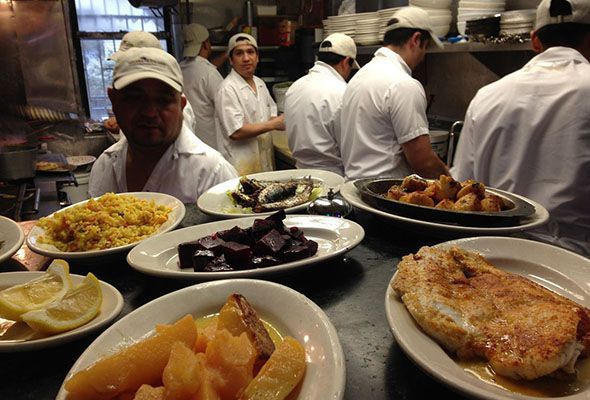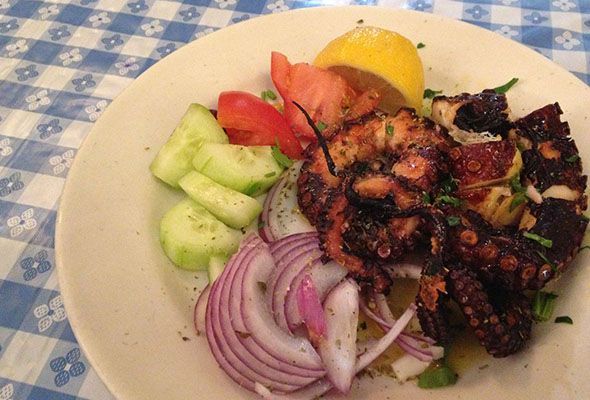
The busy kitchen at Taverna Kyclades serving lunch on a Thursday afternoon. Photo: Alexandra Torrealba.
Modern Meze: Interpreting Culinary Tradition in Greek Astoria
By Alexandra Torrealba
The past and future of Greek cuisine reside on opposite sides of Ditmars Boulevard, in Astoria, Queens.
Astoria has been home to the largest population of Greeks outside of Athens ever since the first wave of immigrants settled there over 50 years ago. In 2012, approximately 35,600 people of Greek ancestry lived in Queens, nearly half of them immigrants born in Greece.
Taverna Kyclades, on the corner of a block decorated with Greek flags, has for the past eighteen years served traditional dishes defined by the freshness and simplicity of preparation: given Greece’s topography, those include grilled seafood like fresh fish, lobster and octopus. Vegetables always complement the main courses, whether cooked or simply sliced into a Greek salad of chopped tomatoes, onions and cucumbers topped with a large chunk of imported feta cheese. A dash of olive oil, lemon and oregano are the mainstays of this 4,000-year-old cuisine.
The bustling taverna, with its blue-and-white façade, stays true to the mantra of simplicity.
“It’s the best recipe,” said 45-year-old Gregory Chatzicharalampous, the head server at the restaurant, as he carried a bowl of Greek salad to a table. He has been working at Kyclades for almost three years. “Our dishes keep their traditional roots. We don’t experiment. There is nothing wrong with modern, but here we are all about broiling and grilling, nothing else. We let the ingredients speak for themselves.”
Taverna Kyclades’ owners Andy Skenderi, who is of Albanian descent, and his wife Caterina, born in United States, but whose family comes from the Greek island of Cephalonia, get their daily meat delivery from the butcher across the street, while Andy visits Hunts Point several times a week to select the restaurant’s fish and seafood. They keep everything in small quantities in a single refrigerator by the kitchen: homemade dips and sauces, ground meat, bags of pita bread, and marinated chicken skewers. “No frozen items here – that’s almost a crime!” Chatzicharalampous said, shaking his head.
One of the most well-known tavernas in the city – ranked third on Zagat’s 2013 list of New York’s best Greek restaurants – the 50-table taverna serves about 150 to 200 customers each day. Diners, from businessmen to families to young couples, feast on large plates of seafood combos, spinach pies, deboned branzino, and Greek-style beef patties (“No bread – that’s American,” says Chatzicharalampous.) The small kitchen functions in controlled chaos; nine kitchen employees rub elbows with each other as one flips a red snapper on the grill, another cleans dishes, and another rings a bell whenever a plate is ready – there can be as many as eight plates neatly stacked into a pyramid on the countertop, waiting to be picked up. A waiter swoops into the kitchen every 30 seconds to follow the same formula: pick up the seafood plate – and its venerated sides of lemon potatoes or cubed beets – drizzle with the lemon-olive oil dressing and sprinkle with oregano. Serve, and repeat.
Across the street, acclaimed chef Michael Psilakis runs the contemporary, Greek-American MP Taverna, where he serves what he calls first-generation cuisine, “the fusion of how you interpret your new world” as an incoming immigrant “through the eyes of the old world” where you come from.
The octopus with mediterranean chickpea salad on MP Taverna’s menu is Psilakis’ modern take on a very simple Greek dish. “Instead of just grilling the octopus and dressing it with a little bit of lemon and extra virgin olive oil,” he said, “we braise it and then we grill it, and then serve it over a salad of chickpeas, black-eyed peas, and a multitude of marinated, pickled and raw vegetables. Then we plate it over a pool of yogurt with a thick, tar-like black olive oil.”
The one thing both places have in common is a commitment to a straightforward approach. “There is just a beauty in the simplicity of Greek food,” said Psilakis. “It offers food in a way that just really allows it to be what it is. It’s ingredients that everybody knows – every local corner grocery store has tomatoes, onions, eggplants, cucumbers and garlic. As long as they are fresh, there’s really not that much you have to do to it to make it taste good.”
While Psilakis uses Greek flavor profiles that would taste familiar to the Greek palate, the concept of recipes passed down from great-grandmothers is not relevant in his kitchen. “We are looking at Greek food through the eyes of a professional kitchen, not a home kitchen, and I really use it as a platform of exploration,” he said. “Nothing that we do technically at MP Taverna is what my mother would do in her kitchen.”
He has redefined the environment as well. The trendy decor has an almost industrial feel that sends a different message from the cozy, familiar feeling at Kyclades. “We’ve been very conscious about actually removing the ethnicity from the ambiance,” Psilakis said, “to allow diners to experience the food without bias, so that they can see the simplicity and the beauty of the food itself.”
For Queens resident Antigone Joannou, who emigrated from Cyprus in 1979, the restaurant’s break from tradition is exactly the reason she keeps coming back. “I don’t go there for Greek traditional food – I make that kind of food at home,” she said. “This food is lighter, and I like that very much.” While Joannou believes that preserving traditions in Greek cuisine is important, MP Taverna is her favorite Greek restaurant in Queens. “I like the different ambiance. It’s a fun place,” she said. “Don’t get me wrong, I love a small little taverna, a real one like we have in Greece, but if you are a person who likes to enjoy food and environment as a whole experience, MP is great.”
While Astoria’s Greek population is growing older – Greek immigration was at its peak in 1976 but has slowly been decreasing – restaurants like MP Taverna are particularly attractive to the neighborhood’s newcomers: young professionals, other immigrants, and Greek-American families. Traditional Greek diners, however, can sometimes be frustrated by the new culinary approach. “Sometimes it’s hard for Greek people, who are very familiar with the food, to really recognize the evolution,” Psilakis said. “It’s a complicated challenge for someone who is true to traditions and has a tremendous amount of respect for traditions. Change for Greeks is almost impossible – there is almost a disdain for it – whereas here in the United States, we embrace change much more easily.”
Psilakis believes that the new look allows diners to identify the food “in a manner that will entice them to start thinking about it as an option on a weekly basis, as opposed to an option of exploration.” Born in New York to Greek immigrant parents, Psilakis says his ultimate goal is to shape the American diner’s mind about what Greek food is, so that it can become as widely embraced as, for example, Italian or Chinese food.
It seems to be about reconsidering traditional cuisine, which is far more diverse than gyros, and has its own allure. “Americans have taken the easy way out when it comes to interpreting Greek food,” said Maria Stavropoulos, owner of Agnanti Meze, a traditional Greek restaurant a few blocks down from MP Taverna. “Gyros in America are considered Greek food, but gyros in Greece are considered junk food. Real Greek food is moussaka and homemade spinach pies.”
Frieda Bletsas, 58, the head cook and owner of Gregory’s 26 Corner Tavern, always draws inspiration from her mother’s cooking when creating the daily specials. “Keeping recipes traditional is very important to me,” said Bletsas, who migrated to New York from her native Greek island of Cephalonia 12 years ago. “My restaurant reminds me of back home in Greece, and that’s how I want my customers to feel: comfortable and at home.”
She starts cooking roasted lamb, vegetable casseroles and moussaka at 7 a.m. and is done cooking the day’s main entrees by 10 a.m., which are then then stored in the oven and heated as customers place their orders. Staying true to the quintessential ingredient in Greek cuisine, Efren Gonzalez, one of Frieda’s kitchen helpers, says the restaurant uses approximately one gallon of imported olive oil per week.
Whichever kind of Greek food it is, the people cooking it are not likely to be Greek.
Given Queens’ large Hispanic population, the predominant language in the majority of these kitchens is Spanish. At Taverna Kyclades, all nine kitchen employees are Hispanic – most of them are Mexican – and many have remained loyal to the owners for years. Mexican baker Gavino Martinez is the only employee trusted with the job of making the restaurant’s one dessert, galaktoboureko, a semolina custard pie wrapped in filo dough and topped with simple syrup and cinnamon, which usually runs out halfway through the night. Gavino’s coworker, Luis Tamay, has worked at the restaurant for 17 years, and has learned to speak and understand Greek.
At Agnanti Meze, a cozy taverna adorned with black-and-white 1960s photographs of Greek musicians and actors, Hispanic hands craft traditional dishes from several regions in Greece. “We need to have Greek people serving the food,” said owner Maria Stavropoulos. “Mostly because they need to be able to translate the dishes and correctly say what is in them.” The cooks, she says, can more easily be trained in Greek cooking methods than in Greek language.
“The difference is not in the hands that make the food,” Stavropoulos said. “It is in the ingredients that you use. The freshness is so important, and the secret is and has always been this: ingredients, ingredients, ingredients.”
Correction: This article has been updated. An earlier version misstated that Taverna Kyclades had been open for eight years, that co-owner Caterina Skenderi was born on Corfu; that the restaurant’s seafood supply comes from a local purveyor. It misstated the number of tables and the ingredients in ground meat patties and galaktoboureko.
Tags: Astoria, Food, Greek, Meze, Octopus

Your Comments